How to Measure Marketing Performance in 2024 (Updated)

It’s impossible to hit your goals if you don’t know how to measure marketing performance.
Before you build brand recognition, make huge marketing investments, generate a number of leads, and convert them to customers at scale, you need to define the KPIs that get you there.
In this guide, we show you the metrics to focus on, and how you can evaluate the value your marketing channels bring to your business automatically.
- How to Measure Marketing Performance
- Best Metrics to Measure Marketing Performance
- Track the Most Essential Marketing Performance Metrics with these Templates
- How to Create a Powerful Marketing Performance Dashboard
- Automate Your Reporting
How to Measure Marketing Performance
Data-driven insights offer a deeper understanding of your customers and business. Without them, you can’t identify what’s working when measuring marketing performance.
For your best chance of success, here are three things you must do.
Define goals and objectives
Goal-setting focuses on what matters.
It provides direction, keeps us organized, and helps us prioritize the most important metrics with a measurable outcome in sight.
Gather all stakeholders in a room to define your company goals. The marketing team should get aligned on the key performance indicators (KPIs) within the group and communicate them to cross-functional departments if needed.
For example, a marketing team that wants to attract more potential customers in a B2B SaaS marketing strategy (goal) might collaborate with the sales team and create the following:
KPI: increase number of qualified leads in sales funnel by 30%
Metrics: click-through rate in emails, product activation rate, free trial conversion rate, etc.
Goal-setting shapes the foundation for your marketing moves. Define your goals before continuing to the next step.
Analyze data
Data analysis involves extracting insights from raw data to make informed decisions.
Start tracking your marketing KPIs and metrics daily, weekly, or monthly.
The earlier you start, the more data you can collect and better understand what’s happening in your marketing campaigns.
You can measure your marketing metrics through an automation-driven reporting tool like DashThis (more on how it works here).
Optimize strategies
Optimization helps you get more out of your marketing efforts, but you don’t always need to invest your dollars in every channel.
Dan Knowlton, Co-founder & CMO @Knowlton says: "Measuring marketing performance is important, but it's useless if you don't take action. Here's an example of ensuring the data we measure leads to actionable insights that improve our actions. In our weekly meeting, we review the data in our bespoke DashThis dashboard & discuss marketing performance. From that discussion, we agree on actions to improve performance before next week's meeting. For example, if our podcast downloads or listen time was down one week, we can set an action to do a deeper dive into the analytics to understand why this happened & what we need to do about it. this is super simple but incredibly important"
Note the monthly advertising campaign report below.
Right away, you can determine which marketing channels perform better. This visual revenue attribution format makes it easy to decide where to allocate your marketing budget for the next campaign.
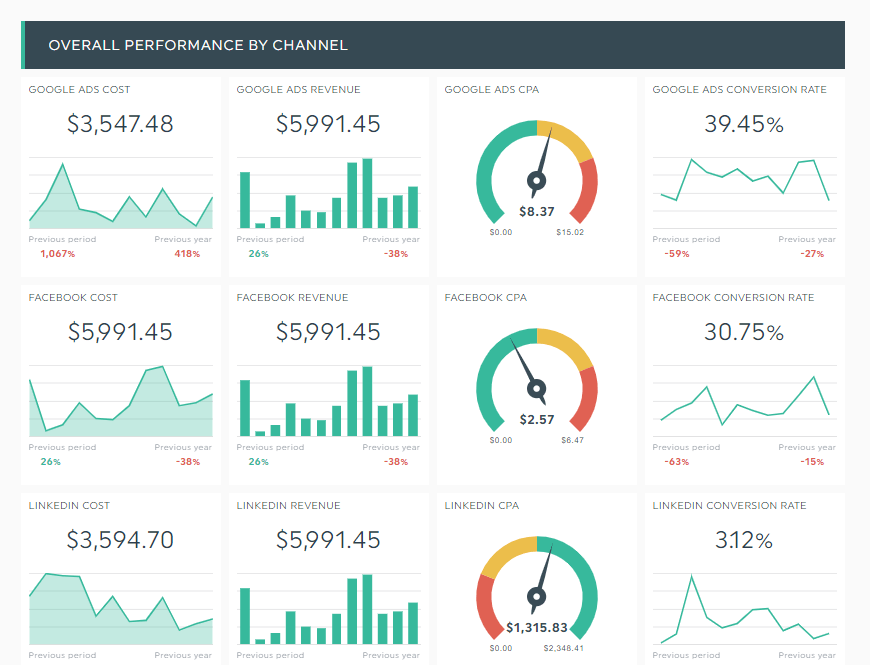
Grab this report with your own data!
And bam, that’s how you impact a business’s bottom line.
Best Metrics to Measure Marketing Performance
The right metrics move the needle forward in your marketing activities. While these metrics depend on the industry, product, and customers, there are several that you can’t go wrong with.
Below is a list of metrics to measure a digital marketing strategy from start to finish.
Brand awareness
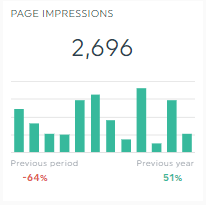
Brand awareness measures how well your target audience recognizes your brand.
Multiple ways to boost brand awareness include collaborating with micro influencers and creating video ads that foster emotional connection.
Common brand awareness metrics include:
- Website traffic (i.e., organic traffic)
- Share of voice
- Impressions
- Brand search volume
- Backlinks (for content marketing)
Lead generation
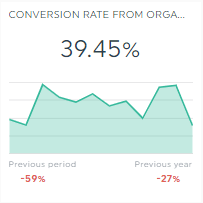
Lead generation is the process of attracting and nurturing prospects, with the end goal of converting them to customers.
Often, it involves driving prospects to a landing page (through paid ads) and getting them to share their email address in a lead capture form.
Common lead generation metrics include:
- Click-through rate (CTR)
- Conversion rate
- Cost per lead
- Qualified leads (e.g., total number of MQL or SQLs)
- Cost per click (CPC)
Engagement
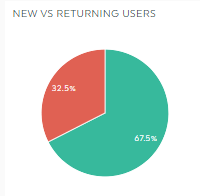
Engagement is the process of interacting with your community meaningfully.
This can look like creating quality content, polling members in a Facebook Group, and posting personalized replies to your audience on Twitter and LinkedIn.
Common engagement metrics include:
- Pageviews
- Engagement rate
- Bounce rate
- Unique website visitors
- New vs. returning visitors
- Number of unsubscribes (e.g., newsletters in email marketing)
Conversions
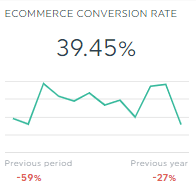
Conversions refer to a completed action performed by a customer (e.g., purchased a product, upgraded to a paid plan from free trial).
Likewise, there are multiple ways to improve this metric. An agency that wants to generate more email sign-ups, for instance, might work on improving its SEO rankings on the search engine.
Common conversions metrics include:
- Conversion rate (also common in lead generation)
- Cost per acquisition (CPA)
- Return on investment (e.g., marketing ROI)
- Retention
- Customer lifetime value (CLTV)
Customer acquisition
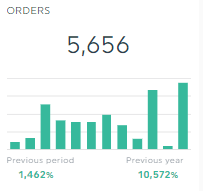
Customer acquisition is getting new customers to buy your product or service.
The right customer acquisition strategy will depend on the industry, product, and customers you sell to. Conduct deep customer research to understand your target customers better. You'll have an easier time acquiring them profitably once you figure that out.
Common customer acquisition metrics include:
- Customer acquisition cost (CAC)
- Average order value (AOV)
- Order frequency
- CLTV (also common in conversions)
- Abandoned cart rate
These metrics, which monitor the entire customer journey, paint an accurate picture of your marketing performance.
Track the Most Essential Marketing Performance Metrics with these Templates
Now that you’ve narrowed down the metrics to monitor across the funnel, consider using the following plug-and-play marketing reports to streamline your reporting workflow.
All-in-one advertising campaign report template
No marketing channel is equal.
Note the automated report below that gathered data from Google Analytics, LinkedIn, and Facebook. It illustrates how each advertising channel contributes to the total revenue.
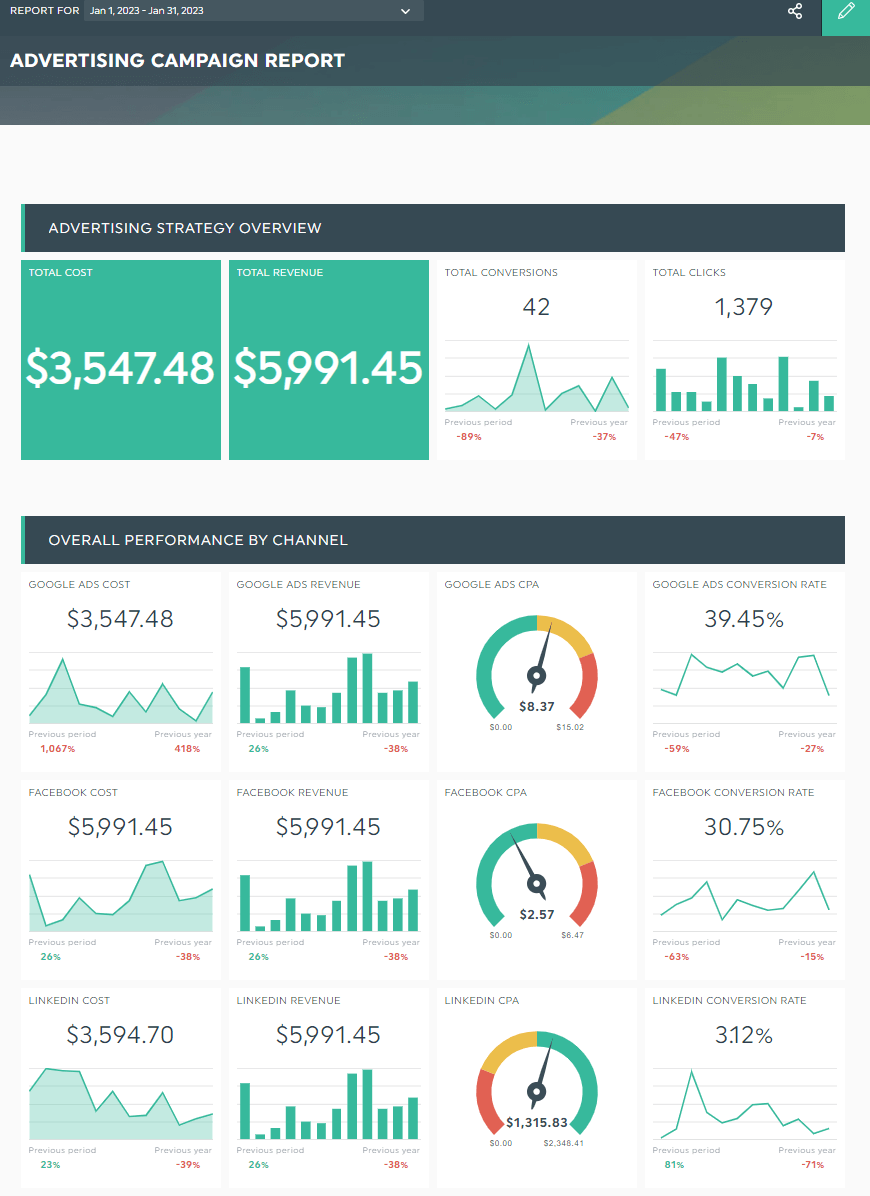
Grab this advertising dashboard with your own data!
Social media report template
Your business doesn’t need to be on all social media channels, though it doesn’t hurt to experiment to tap into a wider audience.
Use the report below if you want to gauge how folks interact with your brand.
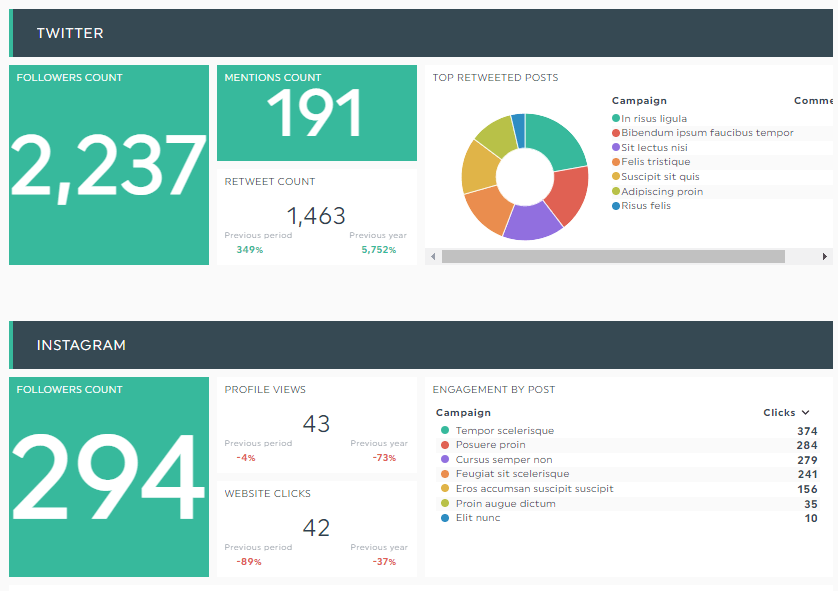
Grab this social media dashboard with your own data!
Ecommerce report template
No ecommerce marketer wants to overspend on advertising.
The dashboard below shows how paid ads and organic traffic contribute to product sales. Note how it visually explains how the number of product views, adds to cart, and checkouts impact the total store sales.

Grab this ecommerce dashboard with your own data!
How to Create a Powerful Marketing Performance Dashboard
With DashThis, you don't have to manually copy-paste data from your marketing tools into spreadsheets.
Our nifty reporting tool auto-grabs your data across multiple platforms and turns them into easy-to-understand graphs in one beautiful report.
Here’s how it works:
- Select a template (OR Blank Dashboard if you want to start from scratch)
- Connect your marketing analytics tools with DashThis
- Pick your metrics in Preset Widgets
DashThis will insert the metrics you selected to the dashboard automatically. Drag and drop them to form a cohesive look.
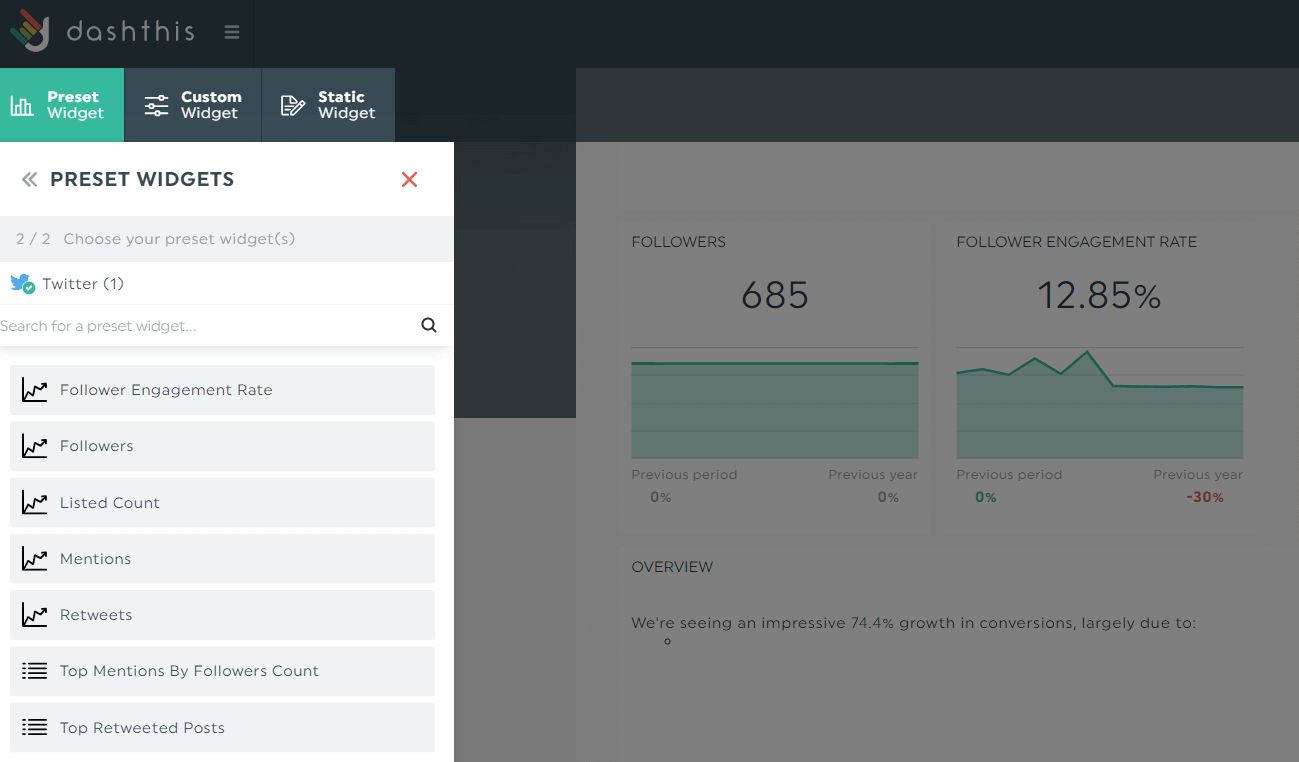
Once you’re done, invite all stakeholders to review the finished report.
You can share it via email or a URL link directly within the platform (note: the latter allows them to view it in real-time).
Automate your Reporting
You can’t build brand recognition and engage with and attract customers if you don’t measure your marketing performance.
Without knowing what’s working, you’re… well, playing darts with your eyes closed.
Get aligned on your goals and objectives with stakeholders and invest in a tool like DashThis to automate your reporting.
DashThis brings all the data you need in one customizable dashboard. Whether it’s Ahrefs, TikTok, or Klaviyo, your KPIs and metrics will be at your fingertips.
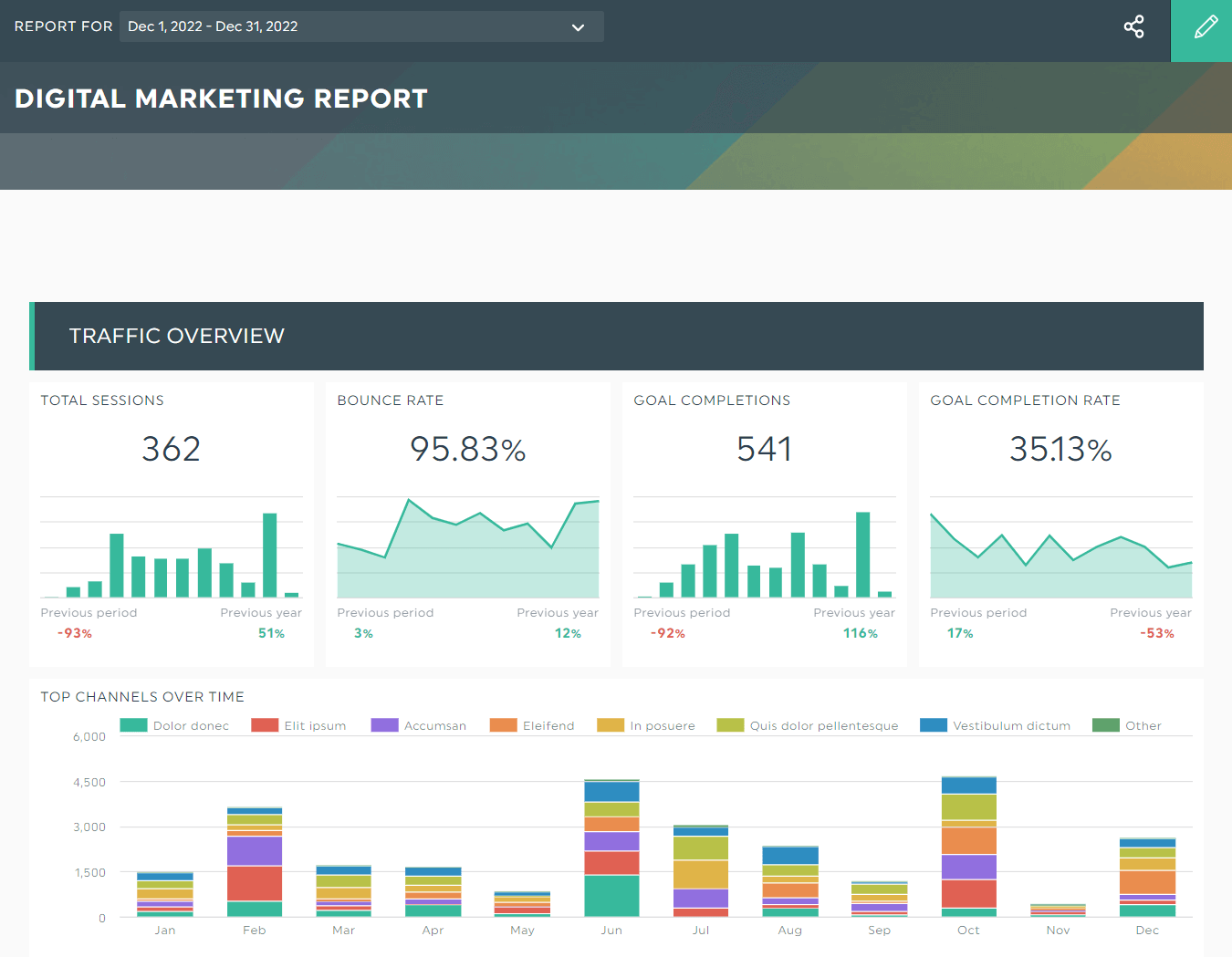
Start your free 15-day trial of DashThis today.
Ready to measure your marketing performance?
Read More
Don’t miss out!
Automate your reports!
Bring all your marketing data into one automated report.
Try dashthis for free

